Israeli choreographer Arkadi Zaides is that mirror in Archive, a demanding but necessary performance presented by Festival TransAmériques. Zaides took a series of video images from B’tselem, an Israeli center for human rights in the occupied territories, only selecting excerpts featuring Israeli men, no doubt to avoid speaking for or against the Other.
Zaides pauses the video, espouses the position of one of its protagonists, spins it 180 degrees, mirrors it, flips it by 90 degrees, leaning against the floor to give us the view of the top of his head, like the one the camera gives us by hovering above the protagonist. Archive is challenging because of its subject matter and its clinical approach, the live dance performance being overshadowed by the video images. When it does work, it’s because of the confrontational attitude that necessarily emerges given the source material, as Zaides walks towards us with aggression in his eyes (the audience is visible throughout the show as the house lights, though dim, remain on) before switching to the movement of a man waving his arms around to try to scare sheep away. Before us, humans become animals that need to be displaced. Zaides often returns to this movement. Archive is at its most powerful near the end, when Zaides replicates the vocalizations of the men in the videos into a microphone, looping them, building a soundtrack that is increasingly oppressive and violent. It’s hard to bear even for a few minutes. Imagine for hours, for weeks, for years… May 24-26 at 7pm Place des Arts – Cinquième Salle www.fta.qc.ca 514.844.3822 Tickets: 39$ / 30 years old and under: 33$
0 Comments
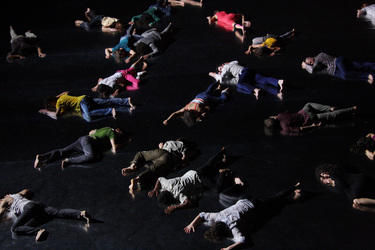 Levée des conflits, photo by Caroline Ablain Levée des conflits, photo by Caroline Ablain As my years as a dance critic pile on, it’s probably to be expected that I see more and more works I’ve already seen. This year, I can think of at least five off the top of my head. The one that most stood up to a repeat viewing was Matija Ferlin and Ame Henderson’s The Most Together We’ve Ever Been. I took the bus to Ottawa to see it just as a snowstorm was hitting the city. The ride ended up taking four hours. I barely had enough time to shove some of the worst food I’ve ever had in my mouth before running over to Arts Court, an old courthouse that has been turned into a beautiful art space. And, as soon as the show started, I knew it was all worth it. Back in Montreal, Israeli choreographer Sharon Eyal made a much-anticipated return after six years with Corps de Walk, a show she created with her partner Gai Behar. The uniformity she imposed on the twelve dancers of Norway’s Carte Blanche was oppressive and disturbing. It was its own indictment of homogeneity. At the Biennale de gigue contemporaine, the always reliable Nancy Gloutnez stood out yet again. With Les Mioles, she borrowed from classical music and became a conductor, turned her dancers’ feet into instruments, and composed a score reminiscent of Steve Reich in its obsessive build-up. After years of being one of the most rigorous emerging choreographers in Montreal, Sasha Kleinplatz has now fully emerged with Chorus II. The audience stood above six male dancers who swayed between demonstrations of physical strength and chill-inducing vulnerability. It is now up to venue artistic directors everywhere to shine on Kleinplatz the spotlight she so clearly deserves. Speaking of which, 2013 was the year of Agora de la danse. They probably had their best programming since I started following dance. It all began with Karine Denault’s Pleasure Dome, in which musicians and dancers explored pleasure without ever lazily resorting to shortcuts. Rather, she allowed the meaning of the work to emerge on its own and for Pleasure Dome to impose itself by the same token. It was followed by When We Were Old, a duo by Québec’s Emmanuel Jouthe and Italy’s Chiara Frigo (presented in collaboration with Tangente). The choreographer-dancers managed to bypass every single contemporary dance cliché that usually occurs as soon as a man and woman are onstage. In each and every moment, their encounter felt fresh and sincere. Agora ended the year with Prismes by Benoît Lachambre, who a month later would win the Montreal Dance Prize. Created for Montréal Danse, Prismes explored the effect of light on perception in a chromatic environment, as well as the fluidity of gender. Lighting designer Lucie Bazzo outdid herself for this highly experiential work. At the Festival TransAmériques, it was French choreographer Boris Charmatz who stood out with Levée des conflits, an opus of twenty-five movements repeated as a canon by twenty-four dancers. From the simplicity of the choreography to the high number of performers, Levée des conflits impressively hovered between minimalism and excess. I spent the summer in Iceland, where my trip ended with the Reykjavík Dance Festival. There, Norway’s Sissel M Bjørkli presented one of the most singular shows I’ve ever seen with Codename: Sailor V. It took place in a tiny space, barely big enough to seat fifteen. The smoke that filled the room along with Elisabeth Kjeldahl Nilsson and Evelina Dembacke’s intensely saturated coloured lighting blurred the edges of everything. Inspired by anime, Bjørkli created an alter ego for herself and through imaginative play managed to turn an office chair into a spaceship. That shit was magical. So was Nothing’s for Something by Belgium’s Heine Avdal and Yukiko Shinozaki, which opened with a ballet for six curtains, each suspended by six huge helium-filled balloons. Set to classical music, it was reminiscent of Disney’s Fantasia. For its finale, eight such balloons were left to float around the room while emitting breathing sounds, appearing like disembodied alien visitors. Soon after my return to Montreal, Marie Chouinard presented Henri Michaux : Mouvements. The genesis of this work, when Carol Prieur first incarnated the drawings of Henri Michaux back in 2005, is the reason why I’m a dance critic today. Seeing the twelve dancers of Chouinard’s company lend themselves to the exercise was just as riveting eight years later. By translating drawings into movement, Chouinard demonstrated the power of dance to think the body creatively. Usine C ended the year on a high note with their program from the Netherlands, most especially Ann Van den Broek’s feminist work for three female dancers, Co(te)lette. The show was powerful in its exposition of women’s bodies as a site of tension, torn between being objects of desire and embodied subjects. We can only hope that there will be more works like it in 2014. My wish for the Montreal dance scene in 2013 is for Marie-Hélène Falcon to quit her job as artistic director of the Festival TransAmériques. I’m hoping she’ll become the director of a theatre so that the most memorable shows will be spread more evenly throughout the year instead of being all bunched up together in a few weeks at the end of spring. With that being said, here are the ten works that still resonated with me as 2012 came to an end. 1. Cesena, Anne Teresa De Keersmaeker + Björn Schmelzer (Festival TransAmériques)
I’ve been thinking about utopias a lot this year. I’ve come to the conclusion that – since one man’s utopia is another’s dystopia – they can only be small in nature: one person or, if one is lucky, maybe two. With Cesena, Belgian choreographer Anne Teresa De Keersmaeker showed me that it could be done with as many as nineteen people, if only for two hours, if only in a space as big as a stage. Dancers and singers all danced and sang, independently of their presupposed roles, and sacrificed the ego’s strive for perfection for something better: the beauty of being in all its humanly imperfect manifestations. They supported each other (even more spiritually than physically) when they needed to and allowed each other the space to be individuals when a soul needed to speak itself. 2. Sideways Rain, Guilherme Botelho (Festival TransAmériques) I often speak of full commitment to one’s artistic ambitions as extrapolated from a clear and precise concept carried out to its own end. Nowhere was this more visible this year than in Botelho’s Sideways Rain, a show for which fourteen dancers (most) always moved from stage left to stage right in a never-ending loop of forward motion. More than a mere exercise, the choreography veered into the metaphorical, highlighting both the perpetual motion and ephemeral nature of human life, without forgetting the trace it inevitably leaves behind, even in that which is most inanimate. More importantly, it left an unusual trace in the body of the audience too, making it hard to even walk after the show. 3. (M)IMOSA: Twenty Looks or Paris Is Burning at the Judson Church (M), Cecilia Bengolea + François Chaignaud + Trajal Harrell + Marlene Monteiro Freitas (Festival TransAmériques) By mixing post-modern dance with queer performance, the four choreographer-dancers of (M)IMOSA offered a show that refreshingly flipped the bird to the usual conventions of the theatre. Instead of demanding silence and attention, they left all the house lights on and would even walk in the aisles during the show, looking for their accessories between or underneath audience members. Swaying between all-eyes-on-me performance and dancing without even really trying, as if they were alone in their bedroom, they showed that sometimes the best way to dramatize the space is by rejecting the sanctity of theatre altogether. 4. Goodbye, Mélanie Demers (Festival TransAmériques) Every time I think about Demers’s Goodbye (and it’s quite often), it’s always in conjunction with David Lynch’s Inland Empire. The two have a different feel, for sure, but they also do something quite similar. In Inland Empire, at times, an actor will perform an emotional scene, and Lynch will then reveal a camera filming them, as if to say, “It’s just a movie.” Similarly, in Goodbye, dancer Jacques Poulin-Denis can very well say, “This is not the show,” it still doesn’t prevent the audience from experiencing affect. Both works show the triviality of the concept of suspension of disbelief, that art does not affect us in spite of its artificiality, but because of it. 5. The Parcel Project, Jody Hegel + Jana Jevtovic (Usine C) One of the most satisfying days of dance I’ve had all year came as a bit of a surprise. Five young choreographers presented the result of their work after but a few weeks of residencies at Usine C. I caught three of the four works, all more invigorating than some of the excessively polished shows that some choreographers spend years on. It showed how much Montreal needs a venue for choreographers to experiment rather than just offer them a window once their work has been anesthetically packaged. The most memorable for me remains Hegel & Jevtovic’s The Parcel Project, which began with a surprisingly dynamic and humorous 20-minute lecture. The second half was an improvised dance performance, set to an arbitrarily selected pop record, which ended when the album was over, 34 minutes later. It was as if John Cage had decided to do dance instead of music. Despite its explanatory opening lecture, The Parcel Project was as hermetic as it was fascinating. 6. Spin, Rebecca Halls (Tangente) Halls took her hoop dancing to such a degree that she exceeded the obsession of the whirling dervish that was included in the same program as her, and carried it out to its inevitable end: exhaustion. 7. Untitled Conscious Project, Andrew Tay (Usine C) Also part of the residencies at Usine C, Tay produced some of his most mature work to date, without ever sacrificing his playfulness. 8. 1001/train/flower/night, Sarah Chase (Agora de la danse) Always, forever, Sarah Chase, the most charming choreographer in Canada, finding the most unlikely links between performers. She manages to make her “I have to take three boats to get to the island where I live in BC” and her “my dance studio is the beach in front of my house” spirit emerge even in the middle of the city. 9. Dark Sea, Dorian Nuskind-Oder + Simon Grenier-Poirier (Wants & Needs Danse/Studio 303) Choreographer Nuskind-Oder and her partner-in-crime Grenier-Poirier always manage to create everyday magic with simple means, orchestrating works that are as lovely as they are visually arresting. 10. Hora, Ohad Naharin (Danse Danse) A modern décor. The legs of classical ballet and the upper body of post-modern dance, synthesized by the athletic bodies of the performers of Batsheva. These clear constraints were able to give a coherent shape to Hora, one of Naharin’s most abstract works to date. Scrooge Moment of the Year Kiss & Cry, Michèle Anne De Mey + Jaco Van Dormael (Usine C) Speaking of excessively polished shows… La Presse, CIBL, Nightlife, Le Devoir, and everyone else seemingly loved Kiss & Cry. Everyone except me. To me, it felt like a block of butter dipped in sugar, deep fried, and served with an excessive dose of table syrup; not so much sweet as nauseating. It proved that there’s no point in having great means if you have nothing great to say. Cinema quickly ruined itself as an art form; now it apparently set out to ruin dance too. And I’m telling you this so that, if Kiss & Cry left you feeling dead on the inside, you’ll know you’re not alone. 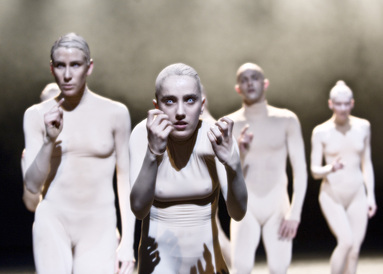 Sharon Eyal & Gai Bachar’s Corps de Walk, photo by Erik Berg Sharon Eyal & Gai Bachar’s Corps de Walk, photo by Erik Berg Benoît Lachambre’s Snakeskins: because you can only accuse Lachambre of being so hit-or-miss due to his uncompromising commitment to his artistic pursuits… and he’s due for a hit. (October 10-12, Usine C) Nicolas Cantin’s Grand singe: because nobody else manages to pack as much punch by doing so little. (October 30-November 1, Usine C) Brian Brooks’s Big City & Motor: because Brooks explores concepts that only push his choreography further into the physical world, turning the human body into little more than a machine. (November 22-25, Tangente) Karine Denault’s PLEASURE DOME: because we haven’t seen her work since 2007, when she presented the intimate Not I & Others using only half of the small Tangente space, dancing with humility, as though the line between performer and spectator simply hinged on a matter of perspective. (February 6-9, Agora de la danse) Pieter Ampe & Guilherme Garrido’s Still Standing You: because Ampe & Garrido have created one of the most compelling shows of the past few years, a dense study of masculinity and friendship covered with a thick layer of Jackass trash. (February 12-16, La Chapelle) Sharon Eyal & Gai Bachar’s Corps de Walk: because it’s the first time we get to see a work by Eyal in six years, when she blew us away with a non-stop human parade that was decidedly contemporary in its transnationalism and use of everyday movements like talking on cell phones. (February 28-March 2, Danse Danse) Mélanie Demers’s Goodbye: because, much like David Lynch did with Inland Empire, Demers demonstrated that an artist doesn’t need to instill suspension of disbelief in its audience to work, that dance can be powerful as dance just as film can be powerful as film. (March 20-22, Usine C) Maïgwenn Desbois’s Six pieds sur terre: because Desbois demonstrated that one doesn’t need to sacrifice art in order to make integrated dance. (March 21-24, Tangente) Yaëlle & Noémie Azoulay’s Haute Tension: because Yaëlle Azoulay came up with the most exclamative piece ever presented at the Biennales de Gigue Contemporaine. (March 28-30, Tangente) Dorian Nuskind-Oder’s Pale Water: because with simple means Nuskind-Oder manages to create everyday magic. (May 10-12, Tangente) 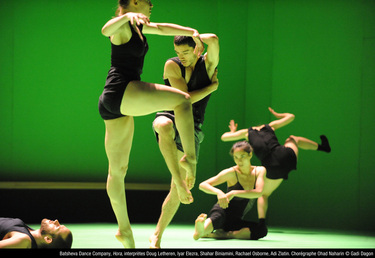 Hora, photo de Gadi Dagon Hora, photo de Gadi Dagon Hora, c’est un titre un peu fourre-tout : ça pourrait tout autant référer à l’astrologie, une danse, une déesse, la prostitution, ou le temps. C’est donc un titre approprié pour la nouvelle pièce d’Ohad Naharin, dont la chorégraphie est elle aussi un peu fourre-tout, tout en évitant le côté péjoratif que le terme pourrait insinuer. On pourrait même parler de cadavre exquis synthétisé par le corps athlétique des onze danseurs. Alors, l’esthétique ne cesse de se balancer d’un bord et de l’autre de la ligne moderne/postmoderne. À l’art visuel moderne on emprunte le décor : des murs uniformes couleur vert lime pastellisée, longés en arrière-scène d’un long banc linéaire où les interprètes peuvent avoir un moment de répit. Côté danse, on recule même dans le temps jusqu’à retrouver les jambes musclées et entrecroisées du ballet, mais supportant un haut-de-corps qui préfère laisser pendre les pattes de devant tel un chien attendant un biscuit-récompense de son maître. De la danse postmoderne, donc, on emprunte un regard sans jugement sur le mouvement. Ceci permet à l’humour de certaines gestuelles d’émerger organiquement sans avoir à le trouver dans une théâtralisation facile. Similairement, des mouvements qui pourraient être perçus comme étant plus féminins ou masculins sont performés par tous les danseurs indépendamment de leur sexe, de sorte qu’ils s’en trouvent simultanément dé/genrés. Cette démocratisation du mouvement fait que la chorégraphie est toute en contraste. Souvent le mouvement n’est pas athlétique, même si les danseurs le sont clairement. Les gestes sont tantôt pausés/posés, tantôt suspendus dans la lenteur, tantôt caféinés. Les mouvements sont souvent répétés tels de petites phrases exclamatives. Par moments, c’est cacophonique, onze soli simultanés; le moment suivant, tout peut être synchronisé. La musique que vous vous imaginez pour supporter tout ça n’est sûrement pas la bonne. Naharin et le musicien Isao Tomita y vont d’un choix particulier et audacieux, des thèmes connus (Also Sprach Zarathustra, La chevauchée des Walkyries, Star Wars) réinterprétés sur synthétiseur. On croirait regarder un film de science-fiction des années 70 avec un petit budget, mais de grandes ambitions (qu’il réaliserait sûrement, d’ailleurs). Bref, le genre de film dont la qualité serait accentuée en fumant un peu. À la fin d’Hora, quand la scène est plongée dans la noirceur et que tout devient un peu flou, la comparaison est encore plus à propos. On se réveille dans un rêve filmique, comme Rosemary avançant lentement à travers le mystère de Rosemary’s Baby. Malgré son apparence fourre-tout, Hora est en fait la chorégraphie la mieux définie que j’aie eu la chance de voir depuis un bail. Une autre façon de dire que c’est pour l’instant le meilleur spectacle de danse présenté à Montréal en 2012. Hora 1-3 mars à 20h Théâtre Maisonneuve www.dansedanse.net 514.842.2112 / 1.866.842.2112 Billets à partir de 27.60$ |
Sylvain Verstricht
has an MA in Film Studies and works in contemporary dance. His fiction has appeared in Headlight Anthology, Cactus Heart, and Birkensnake. s.verstricht [at] gmail [dot] com Categories
All
|
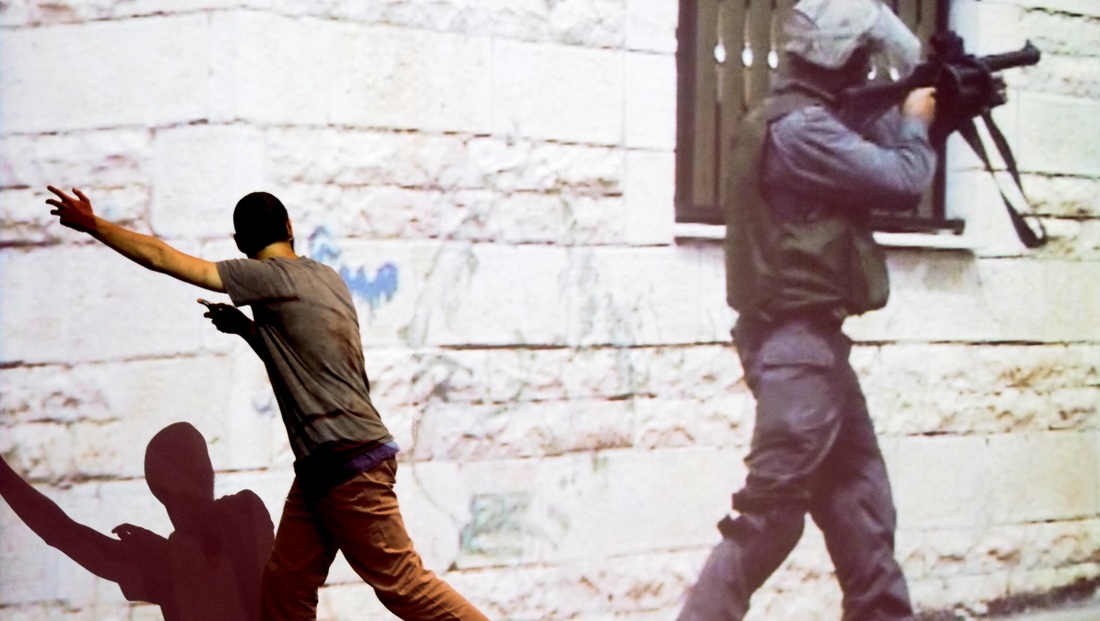
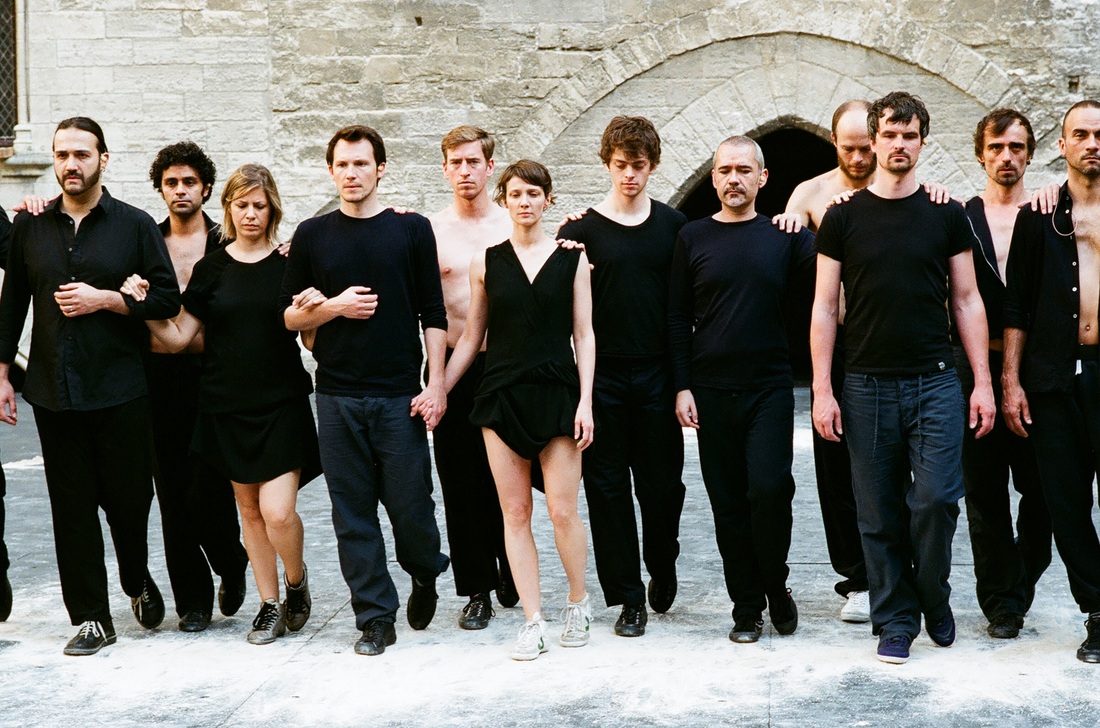
 RSS Feed
RSS Feed